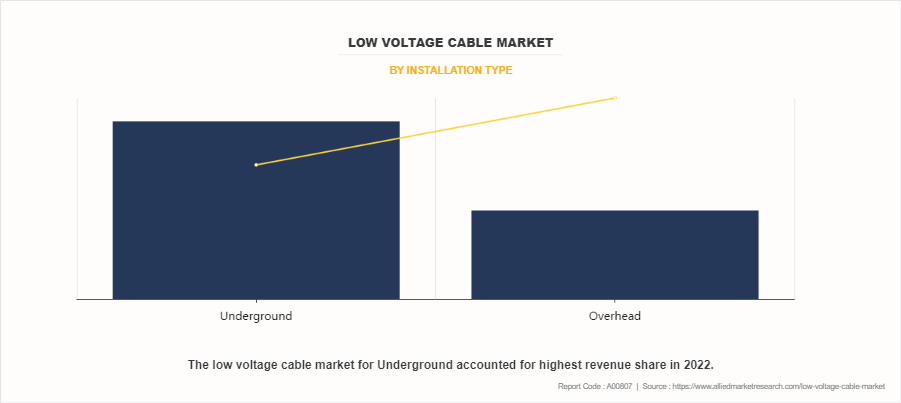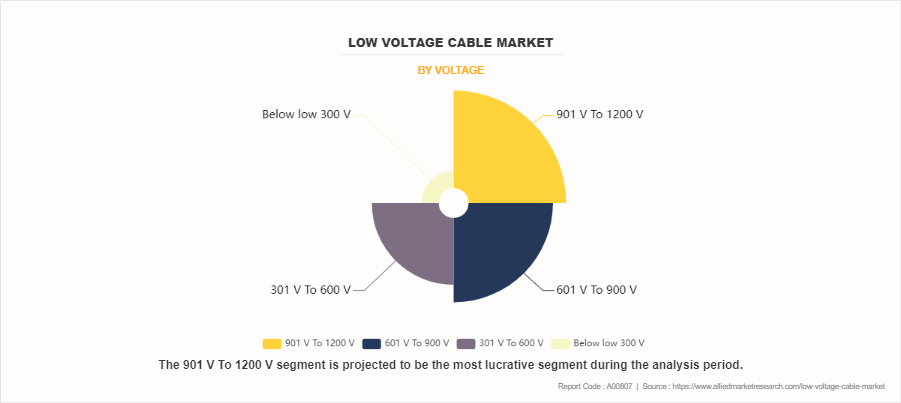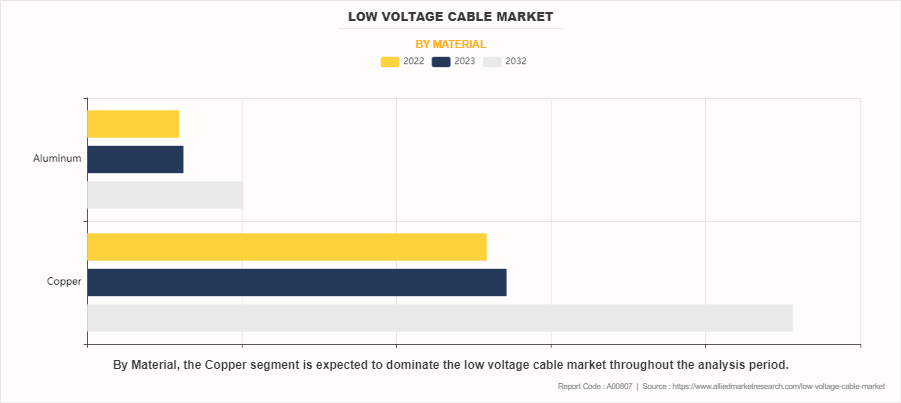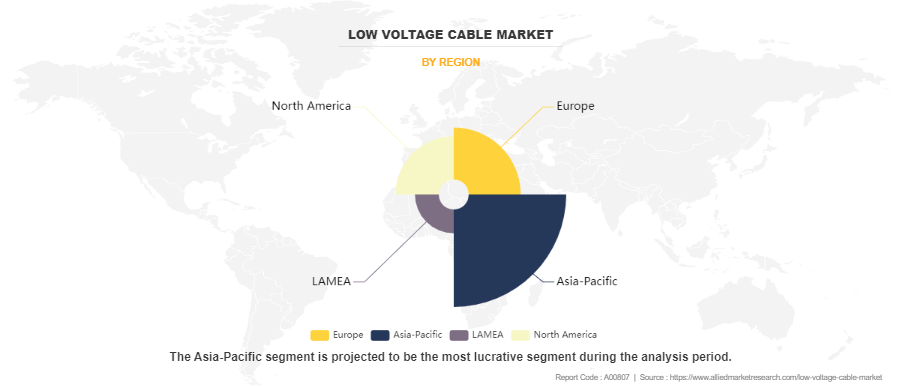Low Voltage Cable Market Research, 2032
The global low voltage cable market size was valued at USD 158.9 billion in 2022, and is projected to reach USD 278.7 billion by 2032, growing at a CAGR of 5.9% from 2023 to 2032. Rise in demand for power generation drives the growth of the low-voltage cables market during the forecast period. However, disadvantages associated with low-voltage cable is expected to restrain the growth of low voltage cables market. Innovation and technological advancement provide lucrative opportunities to the low-voltage cables market.
Key Market Trends
- Underground installations are leading the market, expanding at a CAGR of 5.9% during the forecast period.
- 901 V to 1200 V voltage range dominates the market, with the highest growth at a CAGR of 6.2%.
- Copper-based cables remain the top revenue contributor, growing steadily at a CAGR of 6.0%.
Market Size & Forecast
- 2032 Projected Market Size: USD 278.7 billion
- 2022 Market Size: USD 158.9 billion
- Compound Annual Growth Rate (CAGR) (2023-2032): 5.9%

Introduction
Low voltage cables are constructed with different materials and designs depending on the specific application and requirements. The conductors inside the low voltage cable are usually made of copper or aluminum, which are good conductors of electricity. The conductors are often insulated with materials such as polyvinyl chloride (PVC), cross-linked polyethylene (XLPE), or ethylene propylene rubber (EPR), to provide electrical insulation and protection.
Low voltage cables are extensively employed in industrial control systems for transmitting control signals to control panels, motor controls, sensors, and actuators. They facilitate automation and monitoring of industrial processes. Also, these low voltage cables are used for outdoor lighting and landscape systems, including garden lighting, pathway lighting, and decorative lighting. They supply power to the lighting fixtures while ensuring safety in outdoor environments. In addition, low voltage cables are utilized in renewable energy systems, such as solar power systems and wind turbines. They transmit power from renewable energy sources to inverters, batteries, and electrical systems.
Key Takeaways
The global low voltage cable market share is highly fragmented, with several players including Bahra Electric, Polycab India Ltd., ABB, KEI Industries Limited, NKT A/S, TE Connectivity, Nexans S.A., Sumitomo Electric Industries, Ltd., Prysmian Group, Belden Inc.
More than 6,765 product literatures, industry releases, annual reports, and other such documents of major industry participants along with authentic industry journals, trade associations' releases, and government websites have been reviewed for generating high-value industry insights.
- The study covers nearly 20 countries. The segment analysis of each country in terms of value and volume during the forecast period 2022-2032 is covered in the low voltage cable market market report.
Market Dynamics
There is an increase in need for power distribution networks with the growing global population and rise in energy demand. Low voltage cables play a crucial role in transmitting electrical power from the main grid to end users, such as homes, businesses, and industrial facilities. Also, growing adoption of renewable energy drives the demand for low voltage cables.
These cables are essential for connecting renewable energy systems to the electrical grid, as well as for interconnecting energy storage systems and charging infrastructure for electric vehicles. Moreover, growing demand for telecommunications and data networking is a crucial factor driving the market growth. These cables are used for data transmission, networking, and connectivity in telecommunications systems, ensuring efficient communication and data transfer.
However, the disadvantages associated with low voltage cables, such as limited power transmission and voltage drop are likely to act as a major restraint for market growth. However, innovation and technological advancement are anticipated to offer market growth in coming years. The evolution of smart grid technology and advanced energy management systems has created opportunities for low voltage cables. These cables play a crucial role in interconnecting smart meters, sensors, and distribution devices, enabling efficient energy monitoring, management, and control within the grid.
Segment Overview
The low voltage cable industry is segmented on the basis of installation type, end-use, voltage, material, and region. By installation type, the market is categorized into overhead and underground. By end use, the market is divided into infrastructure, renewable energy, industrial, and others. On the basis of voltage, the market is classified into below 300 V, 301 V to 600 V, 601 V to 900 V, and 901 V to 1200 V. On the basis of material, the market is divided into copper and aluminum. By region, the market is analyzed across North America, Europe, Asia-Pacific, and LAMEA.
Global Market By Installation
Based on installation type, the underground segment accounted for the largest share in the market, contributing to around two-thirds of the global low voltage cable market revenue, and is projected to maintain its lead position during the forecast period. Underground installations of low voltage cables are commonplace in various applications, ranging from residential to industrial settings. These cables play a crucial role in supplying electrical power to homes, buildings, infrastructure, and machinery. Their installation underground offers several advantages, including enhanced safety, reliability, and aesthetic appeal. In 2021, European nations such as Germany and the Netherlands are increasingly opting to replace overhead distribution lines with underground cabling, a trend also observed in India as part of its numerous projects within the 100 smart city initiatives.

Global Market By End Use
Based on end use, the renewable energy segment accounted for the largest share in the market, contributing to around two-fifths of the global low voltage cable market revenue, and is projected to maintain its lead position during the forecast period. One of the primary applications of low voltage cables in renewable energy is in solar photovoltaic (PV) systems. Solar energy is harnessed using photovoltaic panels, which convert sunlight into electricity. Low voltage cables are used to connect these solar panels to inverters, which convert the DC (direct current) electricity generated by the panels into AC (alternating current) electricity suitable for use in homes, businesses, and the electric grid. These cables must be durable and weather-resistant to withstand outdoor conditions and ensure the reliable transmission of electricity from the solar panels to the grid or storage systems.

Global Market By Voltage
Based on voltage, the 901 V To 1200 V segment accounted for the largest share in 2022, contributing to around one-thirds of the global low voltage cable market revenue, and is projected to maintain its lead position during the forecast period. The same segment is projected to grow at a CAGR of 6.2% from 2023 to 2032. Low voltage cables, typically rated between 901 V and 1200 V, serve various applications across industries and sectors. These cables are designed to transmit power efficiently and reliably while operating at lower voltage levels compared to high voltage counterparts. They are essential for distributing power within buildings, powering lighting systems, HVAC (Heating, Ventilation, and Air Conditioning) units, and other electrical appliances.

Global Market By Material
Based on material, copper held the highest revenue accounting for more than half of the market share and the fastest growing segment representing the CAGR of 6.0% during the forecast period. Copper cables are extensively used for electrical wiring in buildings, homes, and industrial facilities. Copper is the preferred choice for low voltage cables due to its excellent conductivity, flexibility, and durability. Its high electrical conductivity ensures minimal energy loss during transmission, making it ideal for efficiently transporting low voltage currents. Additionally, copper's malleability allows for the fabrication of thin wires without sacrificing performance, enabling the production of compact and lightweight cables suitable for various applications. Furthermore, copper exhibits good resistance to corrosion, ensuring the longevity and reliability of low voltage cables in diverse environments.

Global Market By Region
Region wise Asia-Pacific dominated the ow voltage cable market accounting for more than two-fifths of the global low voltage cable market revenue and is likely to dominate the market during the forecast period. The same region is projected to grow at a CAGR of 6.2% from 2023 to 2032. The rapid pace of urbanization and ongoing infrastructure development in various Asian countries is creating a growing demand for low voltage cables to support electrical power distribution and communication networks in residential, commercial, and industrial buildings. Besides, many countries in Asia-Pacific are actively increasing their use of renewable energy sources, such as solar and wind power, to meet their energy needs sustainably.

Which are the Top Low Coltage Cable companies
The following are the leading companies in the market. These players have adopted various strategies to increase their market penetration and strengthen their position in the low voltage cable industry.
- Prysmian S.p.A.
- Nexans S.A.
- Sumitomo Electric Industries, Ltd.
- NKT A/S
- TE Connectivity
- Polycab India Ltd.
- Belden Inc.
- ABB
- Bahra Electric
- KEI Industries Limited
Historic Trends of Low Voltage Cable Market
In the 1800s, telegraph cables, which transmitted electrical signals over long distances, were among the earliest forms of low-voltage cables. These were typically made of copper or iron wires insulated with materials like gutta-percha or rubber.
In the 1880s, the invention and widespread adoption of the telephone led to the development of low-voltage telephone cables, which carried voice signals over shorter distances. These cables were also insulated with materials like gutta-percha or rubber.
In the 1930s advancements in materials science led to the development of more durable and efficient insulation materials, such as synthetic rubber and PVC. This improved the reliability and performance of low-voltage cables for both power distribution and telecommunications.
In the 1980s the advent of computers and digital telecommunications technologies led to the development of specialized low-voltage cables for data transmission, such as twisted-pair cables for Ethernet networks and coaxial cables for cable television and high-speed data connections.
In the 1990s fiber optic cables, which use strands of glass or plastic fibers to transmit data via light signals, emerged as a revolutionary technology for long-distance telecommunications. While not strictly low-voltage in the traditional sense, fiber optic cables revolutionized data transmission and communication networks, offering higher bandwidth and greater reliability compared to traditional copper cables.
Key Benefits for Stakeholders
- This report provides a quantitative analysis of the market segments, current trends, estimations, and dynamics of the low voltage cable market analysis from 2022 to 2032 to identify the prevailing low voltage cable market opportunities.
- The low voltage cable market forecast research offered along with information related to key drivers, restraints, and opportunities.
- Porter's five forces analysis highlights the potency of buyers and suppliers to enable stakeholders make profit-oriented business decisions and strengthen their supplier-buyer network.
- In-depth analysis of the low voltage cable market segmentation assists to determine the prevailing market opportunities.
- Major countries in each region are mapped according to their revenue contribution to the global low voltage cable market scope.
- Market player positioning facilitates benchmarking and provides a clear understanding of the present position of the market players.
- The report includes the analysis of the regional as well as global low voltage cable market trends, key players, market segments, application areas, and market growth strategies.
Low Voltage Cable Market Report Highlights
| Aspects | Details |
| Market Size By 2032 | USD 278.7 billion |
| Growth Rate | CAGR of 5.9% |
| Forecast period | 2022 - 2032 |
| Report Pages | 300 |
| By Installation Type |
|
| By End-use |
|
| By Voltage |
|
| By Material |
|
| By Region |
|
| Key Market Players | Sumitomo Electric Industries, Ltd., NKT A/S, Prysmian Group, Belden Inc., Nexans S.A., ABB, Polycab India Ltd., TE Connectivity, KEI Industries Limited, Bahra Electric |
Analyst Review
According to the opinions of various CXOs of leading companies, the power low voltage cable market is expected to witness increase in demand during the forecast period due to urbanization and industrialization coupled with advancements in technology. Rapid urbanization and industrial development in emerging economies drive the demand for low voltage cables. As cities expand and industries grow, there is a need for reliable power distribution and communication networks, which rely on low voltage cables.
Furthermore, advancements in technology, such as smart homes, Internet of Things (IoT) devices, and automation systems, contribute to the rise in demand for low voltage cables. These cables are required for connecting and powering various devices, sensors, and control systems within smart homes and automated environments.
Low Voltage Cable Market to Garner $278.7 Billion, Globally, By 2032 at 5.9% CAGR
Asia-Pacific is the largest region of low voltage cable market.
Underground is the leading installation of low voltage cable market.
Increase in adoption of renewable energy are the upcoming trends of low voltage cable market in the world.
Key players in the low voltage cable industry include Prysmian S.p.A., Nexans S.A., Sumitomo Electric Industries, Ltd., NKT A/S, TE Connectivity, Polycab India Ltd., Belden Inc., ABB; Bahra Electric, and KEI Industries Limited.
Loading Table Of Content...
Loading Research Methodology...



